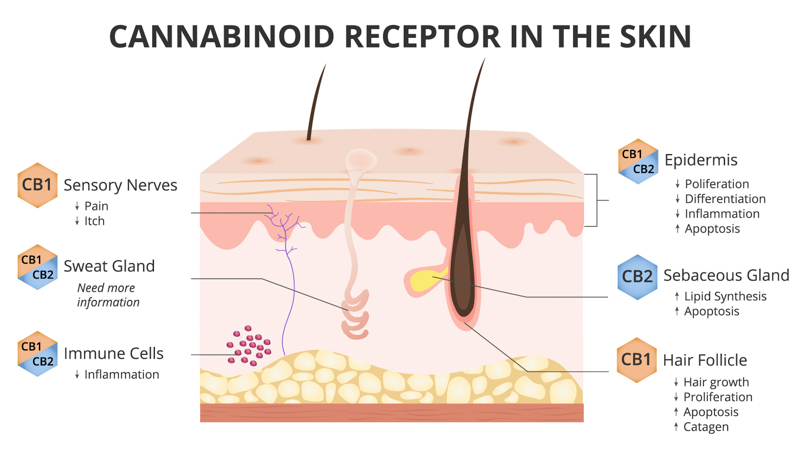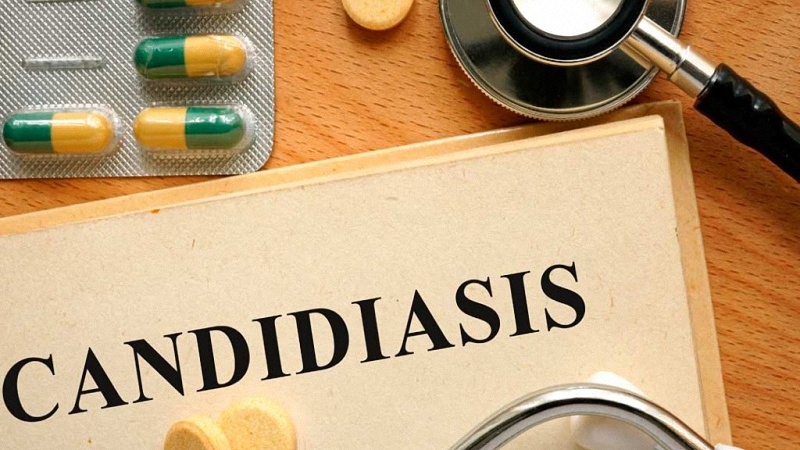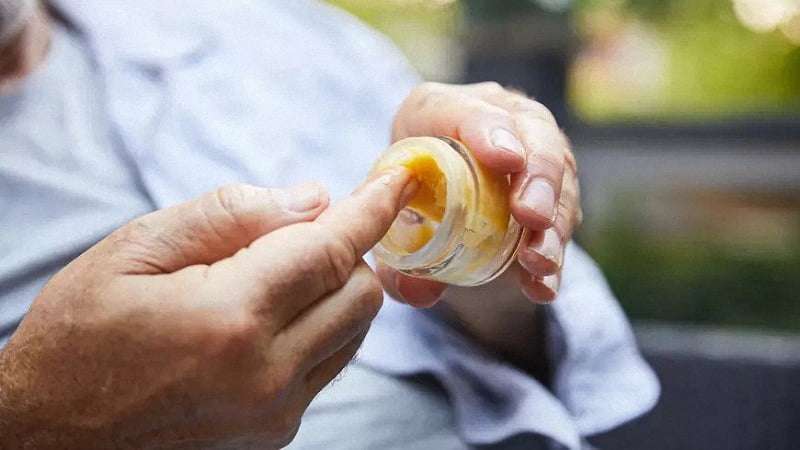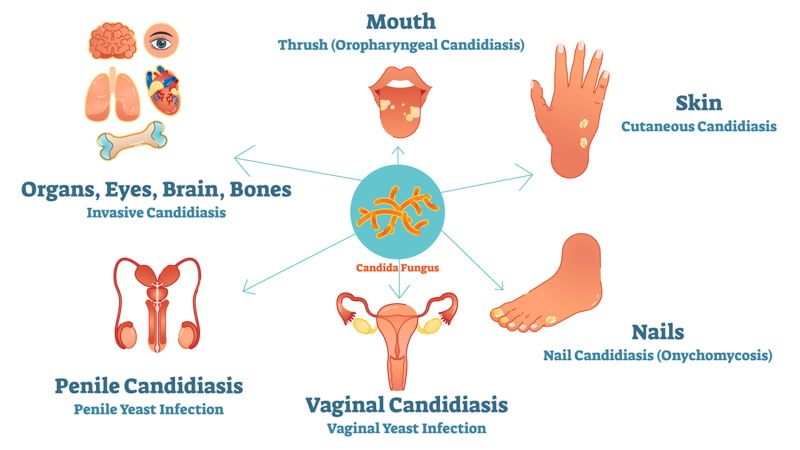CBD Oil for Candida: Benefits, Does It Help, & How to Use?

Medical researchers discovered the endocannabinoid system (ECS) and its receptors in the late 80s. Since then, we have observed a massive amount of research investigating the role of this system in regulating human health. Current evidence has helped us understand the health benefits of CBD and other cannabinoids from hemp. It turns out that humans are hardwired to cannabis — and the ECS is the best proof of that.
Cannabinoid receptors (CB1 and CB2) are found everywhere throughout the body, including the gut microbiome and the cells of the immune system (1). CBD is known to modulate the activity of these receptors, hence its therapeutic effects. In recent years, CBD has been suggested as the potential aid for people with compromised immune systems, especially those suffering from autoimmune conditions and infections.
Is CBD a viable option for candida — one of the most common yeast infections in humans?
While the research in this area is inconclusive, some studies indicate that consistent supplementation with CBD oil may help candida sufferers manage the condition and overcome the problem of itching skin.
Here we present the health benefits of CBD oil for candida.
Why People Are Turning to CBD Oil for Candida?
The ECS is a vast and complex neurochemical network that controls a wide range of biological functions, including memory, mood, pain perception, immune response, cognitive performance, bone growth, neurological functioning, fertility, and more. It is the master regulatory network in all mammals (2).
The ECS is responsible for maintaining the body’s homeostasis — a fancy term for the balance between the aforementioned processes. Whenever that balance is compromised, the system starts to produce increased amounts of endocannabinoids, its natural chemical messengers.
These endocannabinoids bind to the cannabinoid receptors and work to restore homeostasis where it’s needed. The problem is that endocannabinoids are available for the body for a short time span, and the ECS doesn’t store them for later.
This is where CBD steps in. When you take CBD, it interacts with the cannabinoid receptors in the ECS. For one, CBD is an agonist of the CB2 receptor, whose largest concentrations are found in the immune system. Another important mechanism that CBD uses is the signaling of the ECS to produce more of its endocannabinoids. On top of that, CBD inhibits the enzyme that metabolizes these neurotransmitters, making them more available to the body.
With more endocannabinoids circulating in the blood, the endocannabinoid system can restore homeostasis more efficiently, preventing cannabinoid deficiencies and leveling them up when the ECS goes out of whack.
How does it relate to candida?
Let’s take a look.
Is CBD Oil Good for Candida?

The potential benefits of CBD for candida come from its interaction with the CB2 receptors in the ECS — and how CBD modulates the immune response.
Prolonged exposure to pro-inflammatory molecules causes damage to the pain receptors and nerve cells. These molecules, known as cytokines, increase pain signaling caused by nerve damage and worsen the pain from oral and vaginal candida infections.
Upon binding to the CB2 receptors on the surface of the immune cells, CBD lowers hyperactivity and activates anti-inflammatory proteins called caspases (3).
Caspase triggers programmed cell death of cytokines. As their production gets reduced, it facilitates better restoration of a compromised immune system. Moreover, studies show that CBD can reduce skin irritation and itchiness caused by candidiasis through its anti-inflammatory and antipruritic effects.
Is CBD Antifungal?
CBD and other cannabinoids, such as CBC and CBG, have been identified as natural antifungal agents that may help treat candida and other fungal infections.
A 2011 study published in the British Journal of Pharmacology showed that the said cannabinoids have “moderate antifungal properties.” However, the study concentrated on the health benefits of THC, not CBD (4).
Still, the researchers found that CBD, CBC, and CBG may strengthen the effects of a potent antifungal, caryophyllene oxide. This substance is the oxidized form of beta-caryophyllene, one of the most prevalent terpenes found in cannabis, rosemary, pepper, hops, basil, and broccoli.
Terpenes are volatile molecules that are responsible for the unique aromas and flavors of different cannabis strains. They also have their own therapeutic properties, but the most important thing in relation to terpenes and CBD is their ability to enhance the efficacy of cannabidiol through a mechanism known as “the entourage effect.”
The entourage effects is a term first coined by the father of cannabis research Raphael Mechoulam — and further expanded by Dr. Ethan Russo, a neurobiologist, and expert in the cannabis field. It refers to synergistic effects achieved by all cannabinoids, terpenes, and other compounds from the plant. This synergy makes them more effective when they appear next to each other than in isolation. In other words, whole-plant extracts have a greater therapeutic value than isolate-based drugs (5–6).
Some terpenes found in CBD oil can help reduce inflammation, while others are antifungal agents. Combined with the same properties of CBD, they may be helpful in easing the symptoms of candida and making the condition more manageable.
CBD’s anti-inflammatory benefits have been mentioned in several human and animal studies, including the 2010 review that refers to cannabinoids as “novel anti-inflammatory drugs.” (7)
Pros and Cons of Using CBD for Candida
The Pros
- CBD is a remarkable anti-inflammatory agent. Studies also mention CBD’s ability to reduce itching and slow down the growth of fungi, both of which can be helpful for candidiasis patients.
- CBD is non-addictive. Many health agencies, including the World Health Organization (WHO), have acknowledged it as safe for daily use.
- CBD oil and other hemp-derived products are available without a prescription.
The Cons
- There’s a lack of human clinical studies regarding the direct effects of CBD on candida overgrowth. The FDA has only approved CBD as the treatment for epilepsy. However, the medication is based on isolated CBD, not on full-spectrum extracts.
- CBD has a few mild side effects, including drowsiness, diarrhea, dry mouth, and appetite fluctuation. However, these reactions are very rare in normal doses.
- CBD may affect the way your body processes certain medications, including conditional treatments for candidiasis.
- The CBD market is unregulated when it comes to labeling and manufacturing standards, so there’s a risk of buying a fake and dangerous product. If you’re looking for high-quality CBD oil, you should look for a reputable company online. Research is paramount for buying CBD products.
CBD vs. Other Candida Treatments

Healthy individuals with skin candidiasis, thrush, or vaginal yeast infections can deal with them using a short-term treatment or even a single dose of antifungal medication.
However, those with compromised immune systems find candida particularly difficult to treat. For many of them, candidiasis is a recurring ailment.
Most autoimmune diseases are caused by chronic inflammation, and CBD seems to modulate the immune response, reducing its hyperactivity. With a bolstered immune system, yeast infections such as candida may be easier to cure.
On a positive note, most candida infections can be prevented by decent skin hygiene, eating nutrient-dense food, and following a healthy lifestyle. When you catch a candida infection, your doctor may prescribe antibiotics.
One risky side effect of using antibiotics for candida is that they can promote yeast infection in the long run, as studies report. The problem starts when a person takes one antibiotic for candida but then has to deal with the undesired symptoms of a yeast infection.
CBD can support the activity of antibiotics without causing candida overgrowth. As noted by a study performed by the American Society for Microbiology (ASM), CBD kills off Gram-positive bacteria, showing similar results to antibiotics such as vancomycin or daptomycin (8).
The authors of the study said, “The combination of inherent antimicrobial activity and potential to reduce damage caused by the inflammatory response to infections is particularly attractive.”
Other studies have also found CBD to be beneficial at reducing biofilms, a type of bacteria that triggers treatment-resistant infections.
How to Use CBD for Candida?
Different types of candida infections may require different forms of CBD depending on the areas of the body affected by the condition.
Effective Candida treatment requires the user to apply CBD directly where it’s needed. A doctor’s diagnosis should help you determine the type of candidiasis you have. Once there, you’ll need to choose the right product for your situation.
CBD Oil for Candida to Curb Infection from Within
If you suffer from recurring candida infections, you may have a weakened immune system. In this case, some form of CBD oil will be the best option, as using CBD internally helps the ECS reduce hyperactivity in your immune cells.
Sublingual absorption is one of the most efficient methods of taking CBD oil. Its peak blood levels are achieved in 15–20 minutes, which is faster than with oral products. You can choose from oil drops, tinctures, and sprays.
The oil is taken under the tongue, where it absorbs through the tiny blood vessels in the mouth. Direct absorption into the bloodstream increases the bioavailability and potency of CBD.
If you don’t like the taste of CBD oil, you can try CBD capsules, gummies, or honey sticks, which are three common oral products. Oral forms of CBD provide a predetermined amount of CBD per serving; they are also easier to take and more discreet than CBD oil. However, since they are first metabolized in the digestive system, the effects are usually felt after 40–90 minutes.
CBD is also available as vape pens. Vaporization offers the highest bioavailability of all consumption methods, ensuring that up to 56% of the inhaled substance ends up in your bloodstream. The effects are also fast-acting, showing up within minutes after inhalation. However, they also have the shortest duration, up to 4 hours.
CBD Cream for Candida Flare-ups

Topicals, such as CBD creams, gels, lotions, and suppositories, work best for candida infections that are close to the skin or a mucous membrane. These products will bring the most CBD to the target area. Topical formulations may also include other supportive ingredients, such as essential oils and leaf extracts to boost or complement the beneficial effects of cannabinoids.
If you’re using a CBD cream, apply the recommended serving to the affected area and wait until it absorbs into the skin. The absorption rate and duration of effects vary depending on the product’s formula and the type of fat base. You may need to reapply the first dose after a few hours for consistent results.
CBD Dosage for Candida
There are no dosing guidelines when it comes to using CBD for candida.
More high-quality clinical human trials are needed to provide sufficient understanding of different doses of CBD and their impact on any particular health condition. Since the market lacks regulations, it’s difficult to know what you’re buying.
When you get a high-quality CBD oil, read the back of the label to check if the manufacturer provides a recommended serving size. Start low and slow, testing each dosage for about a week. Adjust the amount of CBD oil to the severity of your symptoms, and once you’ve found the amount of CBD that works for you, stick to that dosage. CBD use doesn’t carry a risk of building a tolerance.
Understanding Candida
Candida belongs to the family of fungi that cause an infection known as candidiasis. This condition may cause discomfort, although it’s generally considered to be harmless.
Human bodies host several types of fungi, and candida naturally occurs in minimum concentrations in the oral cavity, digestive tract, gut microbiome, and vaginal tract. When maintained on the right level, candida doesn’t cause any health problems.
However, candida overgrowth doesn’t mean anything good for your body.
Different Types of Candida

Candida overgrowth can lead to an array of unpleasant symptoms. For example, when candidiasis affects the skin, it leaves a red and painful rash that gains a white or yellowish discharge over time. The infection typically manifests itself as fungus in the armpits and between the fingers or groin.
When left untreated, the candida infection may transform into systemic candidiasis, affecting many parts of the body at the same time. Systemic candidiasis is caused by a weakened immune system.
Invasive candidiasis is another fungal infection related to candida overgrowth. It develops when candida species pass into the bloodstream or binds to internal organs such as the brain, heart, or kidney. Invasive candidiasis is usually treated with antifungal medication, as reported by a 2016 study published in the Clinical Infectious Disease Journal.
Typical Candida Symptoms
- Autoimmune diseases caused by leaky gut
- Digestive issues, such as constipation, bloating, and gas
- Skin disorders like dandruff, eczema, rosacea, and Versicolor
- Sugar cravings
- Seasonal allergies or chronic sinus infections
- Fatigue
- Fibromyalgia
How Doctors Diagnose Candida?
There are several methods to diagnose candida. One of them includes running an interview with the patient based on seven basic questions from the book Reset the Yeast Connection by Carolyn G.A. Dean MD ND (9).
Demand introduces the term Yeast Overgrowth Syndrome (YOS) to talk about candidiasis, Candida-related complex, Candida hypersensitivity, and allergies to yeast.
The list includes the following questions:
- Have you, at any time in your life, taken broad-spectrum antibiotics?
- Have you taken antibiotics (mostly tetracycline) for more than one month?
- Do your symptoms get worse on damp, muggy days or in moldy places?
- Do you have sugar cravings?
- Do you have a feeling of being drained?
- Are you bothered with vaginal (or penile) discharge or burning itching?
- Are you bothered by burning, itching, or tearing eyes?
How is Candidiasis Commonly Treated?
According to a 2014 study published in the Journal of Clinical and Experimental Dentistry, the following drugs are effective candida treatment:
- Nystatin
- Amphotericin B
- Fluconazole oral suspension
The above compounds were analyzed in terms of their efficacy in treating oral candidiasis (10).
For skin candidiasis, the study highlighted different antifungal powders and creams as effective medications. The research team also stressed the importance of keeping the skin surrounding the problematic area clean and dry for the treatment’s duration.
When it comes to vaginal yeast infections, the authors of the study recommend antifungal medications to reduce their frequency and severity. More studies are needed to determine if any alternative therapies can treat vaginal candidiasis.
The study suggested that patients use the above medications along with complementary therapies, such as herbal treatments, under a physician’s supervision.
Summarizing the use of CBD for Candida
CBD has been highlighted multiple times as a natural treatment for fungal infections. The anti-inflammatory, antipruritic, and painkilling properties of CBD oil may prove useful in relieving the symptoms of candida overgrowth and further infections.
Candida overgrowth is categorized into different types depending on the area of the body it affects. The choice of the treatment, as well as types of CBD products, will also vary depending on your situation.
To date, no study has analyzed CBD’s efficacy and dosage specifically for candida. If you’re considering adding CBD oil to your daily routine, make sure to consult a doctor, preferably a holistic dermatologist, in order to establish an accurate dosing strategy and avoid negative interactions with antifungal medications.
When choosing the best CBD oil for candida, it’s essential to research your potential supplier roots to branches, from hemp farming practices to extraction technology and laboratory testing.
Literature:
- Lu, Hui-Chen, and Ken Mackie. “An Introduction to the Endogenous Cannabinoid System.” Biological psychiatry vol. 79,7 (2016): 516-25. doi:10.1016/j.biopsych.2015.07.028
- Kaur, Rimplejeet et al. “Endocannabinoid System: A Multi-Facet Therapeutic Target.” Current clinical pharmacology vol. 11,2 (2016): 110-7. doi:10.2174/1574884711666160418105339
- Rom, Slava, and Yuri Persidsky. “Cannabinoid receptor 2: potential role in immunomodulation and neuroinflammation.” Journal of neuroimmune pharmacology: the official journal of the Society on Neuroimmune Pharmacology vol. 8,3 (2013): 608-20. doi:10.1007/s11481-013-9445-9
- Russo, Ethan B. “Taming THC: potential cannabis synergy and phytocannabinoid-terpenoid entourage effects.” British journal of pharmacology vol. 163,7 (2011): 1344-64. doi:10.1111/j.1476-5381.2011.01238.x
- Ben-Shabat, S et al. “An entourage effect: inactive endogenous fatty acid glycerol esters enhance 2-arachidonoyl-glycerol cannabinoid activity.” European journal of pharmacology vol. 353,1 (1998): 23-31. doi:10.1016/s0014-2999(98)00392-6
- Russo, Ethan B. Op. Cit.
- Nagarkatti, Prakash et al. “Cannabinoids as novel anti-inflammatory drugs.” Future medicinal chemistry vol. 1,7 (2009): 1333-49. doi:10.4155/fmc.09.93
- American Society for Microbiology (2017). “Cannabidiol is a Powerful New Antibiotic.”
- Dean, C.A.F. “Reset the Yeast Connection.”
- Garcia-Cuesta, Carla et al. “Current treatment of oral candidiasis: A literature review.” Journal of clinical and experimental dentistry vol. 6,5 e576-82. 1 Dec. 2014, doi:10.4317/jced.51798